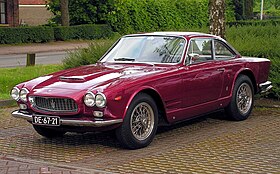| Maserati Sebring | |
|---|---|
 Maserati Sebring Series I | |
| Overview | |
| Manufacturer | Maserati |
| Also called | Maserati 3500 GTiS |
| Production | 1962–1969 593 produced |
| Designer | Giovanni Michelotti at Vignale |
| Body and chassis | |
| Class | Grand tourer |
| Body style | 2+2 coupé |
| Layout | Front-engine, rear-wheel-drive |
| Chassis | tubular |
| Related | Maserati 3500 GT |
| Powertrain | |
| Engine | 3485 cc Tipo AM101, 101/10 I6, Lucas fuel injection 1965–1968: 3,694 cc Tipo AM106 1965–1968: 4,012 cc Tipo AM106/1 |
| Transmission | ZF 5-speed manual optional Borg-Warner 3-speed automatic |
| Dimensions | |
| Wheelbase | 2,500 mm (98.4 in) |
| Length | 4,470 mm (176.0 in) |
| Width | 1,665 mm (65.6 in) |
| Height | 1,300 mm (51.2 in) |
| Curb weight | 1,520 kg (3,351 lb) (dry) |
| Chronology | |
| Predecessor | Maserati 3500 GT |
| Successor | Maserati Indy |
The Maserati Sebring was a two-door 2+2 coupé manufactured by Maserati from 1962 until 1968. Based on the Maserati 3500, the Sebring was aimed at the American Gran Turismo market and named after Maserati's 1957 racing victory at the 12 Hours of Sebring. A single two-seat spyder was built by Vignale in 1963 but did not enter production.[1]
- ^ Tabucchi, Maurizio (2003). Maserati: The Grand Prix, Sports and GT cars model by model, 1926-2003. Milano: Giorgio Nada Editore s.r.l. p. 249. ISBN 8879112600.